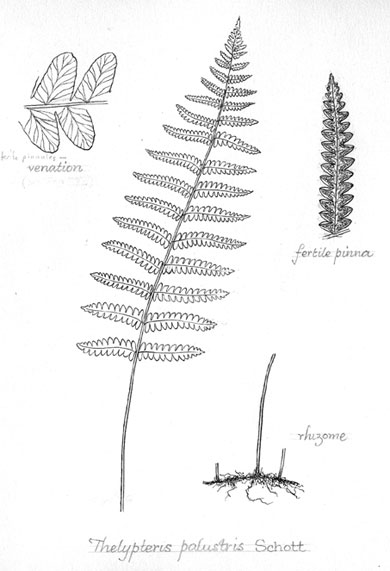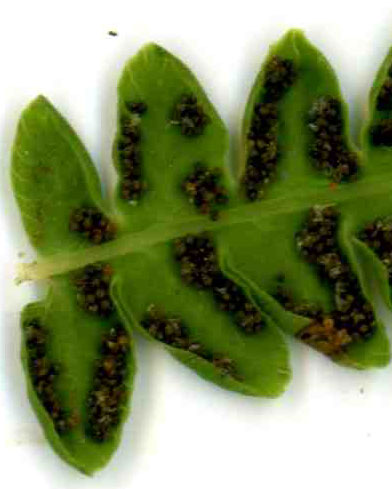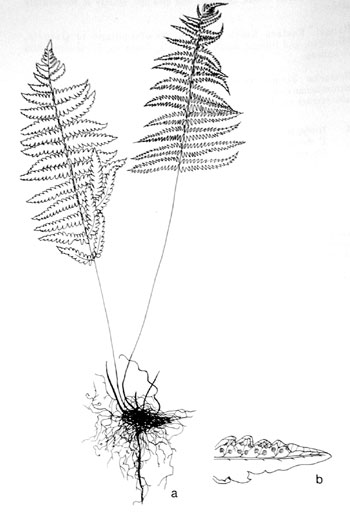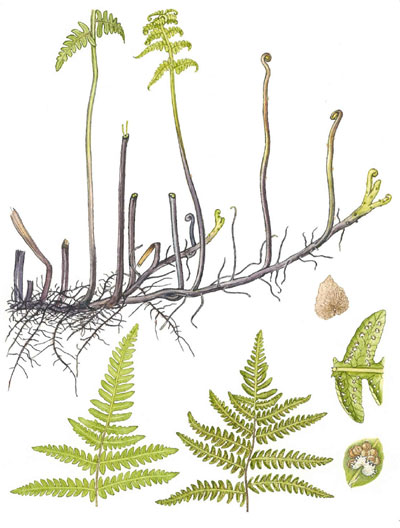| Thelypteris palustris | ||
Marsh fern | ||
|
Etymology
Palustris means marshy or swampy.
Description
Rhizome: long-creeping, branching, black behind a white tip, 2.5 mm diam., cordate scales.
Frond: 75 cm high by 20 cm wide, deciduous, monomorphic, though sterile fronds are earlier, fertile narrower, taller, 6 weeks later, blade/stipe ratio: 1:1 to 3:1. Stipe: straw-colored or darker, shading to green, a few scales near the base, vascular bundles: 2, oblong, at 90°, at stipe base, merging above to an open u-shape. Blade: 1-pinnate-pinnatifid, lanceolate, widely separated pinnae, tapering to the tip, widest below the middle, narrowing somewhat to the lowest pinna, membranous, pale green, short, whitish hairs, falling soon, and yellow glands. Pinnae: 14 to 20 pair, lanceolate, long tapering, less incised near the ends, 2 cm wide; costae grooved above, discontinuous with the rachis; margins sterile: entire to slightly toothed, fertile: narrower, triangular, folded downward; veins free, once-forked. Sori: round, midway between the margin than the costule, merging into each other, indusium: small, irregular or somewhat reniform, shedding soon, maturity: mid to late summer. Culture
Habitat: swamps, bogs, and marshes, also along riverbanks and roadside ditches, and in wet woods .
Distribution: Europe and northern Africa, western and central Asia, China; var. pubescens eastern North America, Bermuda, Cuba, Japan, northeastern Asia; var. squamigera in New Zealand.
Hardy to -35°C, USDA Zone 3.
Distinctive Characteristics
The long-running rhizome separates this from many ferns, the wide lowest pinnae pair distinguishes this from T. noveboracensis, and the 1-pinnate-pinnatifid division here from Dennstaedtia punctilobula.
Synonyms
Acrostichum thelypteris L Polypodium palustre Salisb. Lastrea thelypteris (L.) Bory Thelypteris thelypteroides (Michaux) Holub Dryopteris thelypteris (L.) Gray var. pubescens (Lawson) Nakai |
|
|
Notes
Compare to T. simulata is similar but has all the veins unforked.
Compare to T. simulata is similar but has all the veins unforked.

Thelypteris palustris. Note the venation. The forking separates this from T. simulata. Illustration by Edgar Paulton, from How to Know the Ferns and Fern Allies, John T. Mickel, © 1979 Wm. C. Brown Co. |

Thelypteris palustris. Two oval to elongate vascular bundles at the base of the stipe uniting above to an inverted v-shape above. Drawing from Ferns of Northeastern United States, Farida A. Wiley, 1936. |

Thelypteris palustris. Base of pinna, 10 September. Fertile fronds late summer. Note recurved margins. Scan: Tom Stuart |

Thelypteris palustris. a) fronds, sterile left, fertile right; b) fertile pinna, margins inrolled, lowest veins meeting the margin above the base of the pinnules and at least some veins forking. Illustration by V. Fulford from Ferns and Fern Allies of Canada, William J. Cody and Donald M. Britton, 1989, © Agriculture Canada, used with permission. |
